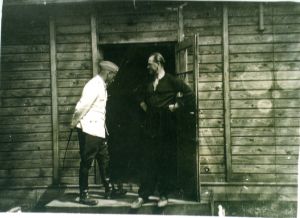Franz Stangl

Stangl and Franz outside the German Quarter in Treblinka
Franz Paul Stangl was born in Altmunster, a market town on the western shore of the Traunsee, near Gmunden, in Upper Austria, on 26 March 1908. His father was already advanced in years, whereas his mother was still a young woman, they had one other child, a daughter ten years older than Franz. When Franz was eight years old, in 1916, his father died of malnutrition, after which his mother remarried to a widower a year later, thus Franz gained two step-
After leaving school aged 15, he became an apprentice in the weaving trade, and three years later qualified as a master weaver, the youngest in Austria. Five years later, in 1931, he realised his job held no further prospects for him, and he applied to join the Federal Austrian Police. After acceptance and a year’s training at the police school in Linz, he served his probation, first in the Traffic Division and then with the Riot Squad. He recalled his tough training with some bitterness and that his colleagues were a ‘sadistic lot,’ who were indoctrinated with the feeling that everyone was against them, and that ‘all men were rotten.’ In 1935 he was transferred to the political division of the criminal investigation department in the small Austrian town of Wels and a year later he became a member of the illegal Nazi Party. After the Nazi annexation of Austria in March 1938 Stangl’s department was absorbed into the Gestapo, and the Wels police department was transferred to Linz, and Stangl was promoted to the rank of Krimminal-
On 3 November 1940 he joined the T4 Euthanasia programme and without delay was sent to Schloss Hartheim near Linz, as deputy head of the administration. Later Stangl was sent to the euthanasia institution at Bernburg, where Dr Eberl was in charge, to carry out the same role. Stangl who held the rank of Polizeioberleutnant, was also a member of the Sicherheitsdienst – SD). In the early spring of 1942 Stangl was ordered to report to Lublin, and was appointed by Odilo Globocnik to the role of commandant at the Sobibór death camp, in eastern Poland. Stangl was in charge when the camp received its first Jewish transports in May 1942. It was in Sobibór where he exploited his weaver skills to sew himself the famous white linen uniform which later gave him the nickname ‘White Death’. He preferred to wear this uniform because of the insects and a heat in the Sobibór and Treblinka camps during the summer. Around the period late August 1942 Stangl was transferred from Sobibór to Treblinka to take over the command of the death camp from Dr Eberl, who had proved unequal to the task.
Stangl had a flair for organisation, he maintained very little contact with the victims he sent to their deaths, or the Jewish prisoners; he was seen only on rare occasions. He received an official commendation as the “best camp commandant in Poland.” He survived an attack by partisans on 30 July 1943, travelling from Sobibor towards Chelm, according to a Police report. This happened just before the revolt at the Treblinka death camp on 2 August 1943. After the Treblinka revolt he was posted to northern Italy, where he spent a short time at San Sabba camp in Trieste. Stangl mainly served as the commander of Einsatz R II in the Fiume and Udine areas, where he was engaged in construction projects and actions against partisans and Jews. At the end of the war he fled to Austria, where he was interned by US forces, because of his SS membership. From the late summer of 1947 he was imprisoned in Linz, accused of having killed mentally – ill patients at Hartheim. In May 1948 he escaped from prison and made his way to Rome in Italy. There he received help from Bishop Hudal, who arranged for a Red Cross passport and money for his flight to Syria, where he obtained a job in a textile factory in Damascus. His wife and family joined him in Syria and Stangl got a job as a mechanical engineer with the Imperial Knitting Company.
In 1951 he migrated to Brazil with his family and in Sao Paulo he worked in the Volkswagen factory. It was not until mid-
Sources
C.Webb & M. Chocholaty, The Treblinka Death Camp, Ibidem-
G. Sereny, Into That Darkness – From Mercy Killing to Mass Murder, Pimlico. London, 1974
Police Report – YVA 0.53.122.2
Photograph – Kurt Franz Album
Shaul Fererro – Yad Vashem
© Holocaust Historical Society 2014

